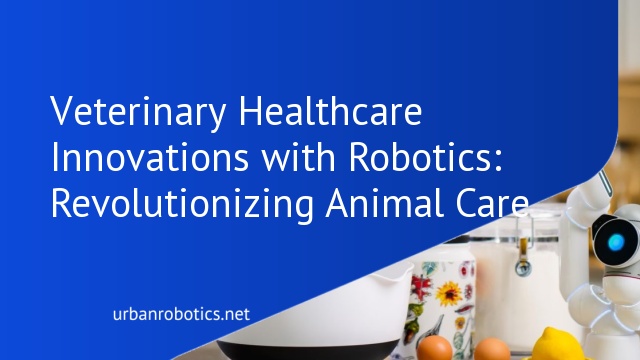Understanding Veterinary Robotics
Veterinary robotics refers to the application of robotic technologies in animal healthcare. These technologies include automated diagnostic tools, robotic-assisted surgeries, and rehabilitation devices. Automated diagnostic tools, such as lab automation systems, enhance the accuracy of tests and reduce waiting times. Robotic-assisted surgeries provide precision which lowers the risk of complications and speeds up recovery.
Rehabilitation devices, like robotic limbs and therapy robots, help animals regain mobility and function more effectively. Advanced imaging technologies, including robotic endoscopes and ultrasound machines, deliver high-resolution images, improving diagnostic accuracy. Robotics helps veterinarians to perform complex procedures with greater precision, enabling minimally invasive surgeries and reducing patient stress.
Further, telemedicine platforms integrated with robotic systems enable remote diagnostics and consultations. These innovations expand veterinary care access, especially in rural or underserved regions. Veterinary robotics ultimately enhances care quality, improves outcomes, and makes veterinary treatments more efficient and accessible.
Key Innovations in Veterinary Robotics
Veterinary robotics is revolutionizing animal healthcare. Below, we explore key innovations enhancing this field.
Surgery Assistance
Robotic systems assist surgeons in performing precise, minimally invasive procedures. Devices like robotic arms allow for enhanced dexterity and control, minimizing tissue damage and reducing recovery times. For instance, robotic-assisted spaying and neutering procedures have seen a marked decrease in post-operative complications, providing safer surgical options for pets.
Diagnostic Tools
Advanced diagnostics benefit significantly from robotics. Automated imaging tools such as robotic ultrasound machines and endoscopes offer high-resolution images, enabling accurate medical assessments. For example, robotic systems can perform complex imaging tasks with consistent precision, facilitating early detection of diseases and improving treatment outcomes.
Rehabilitation and Therapy
Innovations in robotic rehabilitation aid in animal recovery. Devices like robotic exoskeletons and treadmills provide tailor-made therapy programs for injured animals. These technologies help in restoring mobility and function more effectively than traditional methods. For instance, robotic underwater treadmills are used to build strength and promote healing in rehabilitating animals.
Benefits of Robotics in Veterinary Healthcare
Advancements in robotics offer numerous benefits in veterinary healthcare. By leveraging these technologies, we enhance precision, recovery, and diagnostic capabilities for better animal care.
Precision and Accuracy
Robotic systems offer unparalleled precision and accuracy in veterinary procedures. Automated surgical tools enable veterinarians to perform delicate operations with steady hands and minimal human error. For instance, during orthopedic surgeries, robots assist in precise bone cutting and alignment. This precision reduces risks and improves surgical outcomes. Diagnostic tools like robotic ultrasound machines provide high-definition images, ensuring accurate assessments and treatments.
Enhanced Recovery Times
Robotics significantly reduce recovery times for animals by promoting minimally invasive procedures. Robotic-assisted surgeries involve smaller incisions, leading to less tissue damage and faster healing. For example, robotic spaying and neutering result in quicker recovery and lower post-operative pain compared to traditional methods. Additionally, robotic rehabilitation devices like exoskeletons help animals regain mobility and strength efficiently, facilitating quicker recovery from injuries.
Improved Diagnostics
Robotic technologies enhance diagnostic capabilities in veterinary healthcare. Advanced imaging tools, such as robotic endoscopes, capture detailed internal views, aiding in early disease detection. Automated diagnostic systems process and analyze data rapidly, leading to timely and accurate diagnoses. This improvement in diagnostics enables veterinarians to devise effective treatment plans, increasing the chances of successful outcomes. For instance, early detection of tumors through robotic imaging tools provides crucial information for prompt intervention.
Challenges and Limitations
While robotics in veterinary healthcare offers numerous benefits, it also presents several challenges and limitations.
High Costs
Implementing robotic systems in veterinary practices incurs significant expenses. Initial purchase prices for equipment like robotic-assisted surgery systems can exceed $500,000. Maintenance and repair costs add to this financial burden. Small clinics might struggle to justify such investments, limiting advanced care options for animals.
Technical Training
Veterinary staff require specialized training to operate robotic systems. Learning to handle these advanced tools demands considerable time and resources. Limited training programs and steep learning curves can hinder the widespread adoption of robotics, affecting the overall efficacy and success of these innovations.
Future Prospects of Veterinary Robotics
Veterinary robotics promises significant advancements. Emerging technologies like AI integration with robotic systems enhance diagnostics and treatment precision. AI algorithms can analyze large sets of veterinary data, enabling more accurate disease prediction and personalized treatments. Expanded use of robotic-assisted surgeries increases and refines minimally invasive procedures, further reducing animal recovery times.
Robotic rehabilitation technologies show potential for development. Advanced exoskeletons and treadmills may become more accessible, allowing more animals to benefit from customized therapy programs. This can drastically improve the quality of life for animals recovering from injuries or surgeries. We may witness advancements in robotic-assisted diagnostic tools, making these devices more affordable and widespread.
Education and training programs for veterinary robotics likely expand, addressing current barriers. Universities and vocational schools can include specialized courses, reducing the knowledge gap and encouraging more widespread adoption of robotic systems. Cost reduction through technological advancements and market competition may also make these innovations more accessible to veterinary practices worldwide.
Future veterinary robotics holds promise in providing better care, though it will require overcoming current financial and educational obstacles.
Conclusion
Robotics in veterinary healthcare is revolutionizing the way we care for animals. From automated diagnostics to robotic-assisted surgeries these innovations offer unprecedented precision and efficiency. While challenges like high costs and specialized training remain the future looks promising with advancements in AI and more accessible technologies. As we continue to develop and integrate these tools we can look forward to a future where veterinary care is more effective and widely available ensuring the well-being of our animal companions.





